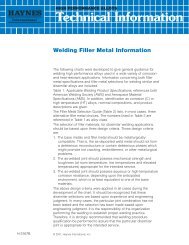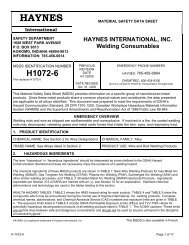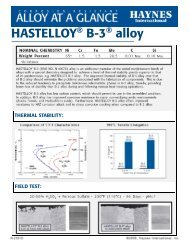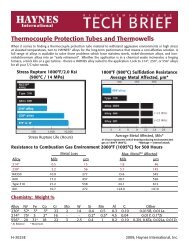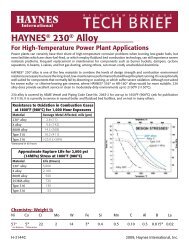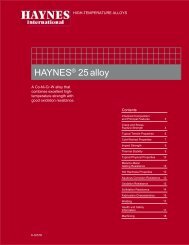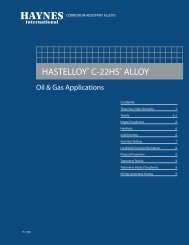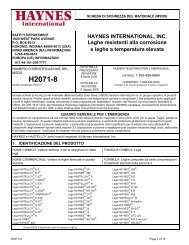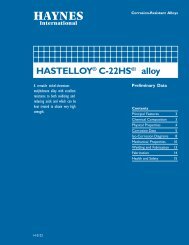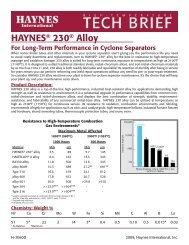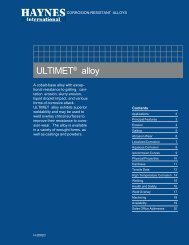HAYNES® 556™ alloy - Haynes International, Inc.
HAYNES® 556™ alloy - Haynes International, Inc.
HAYNES® 556™ alloy - Haynes International, Inc.
- No tags were found...
You also want an ePaper? Increase the reach of your titles
YUMPU automatically turns print PDFs into web optimized ePapers that Google loves.
PRINCIPAL FEATURESHigh Strength and Resistanceto High-TemperatureCorrosionHAYNES ® 556 <strong>alloy</strong> is aniron-nickel-chromium-cobalt<strong>alloy</strong> that combines effectiveresistance to sulfidizing, carburizingand chlorine-bearingenvironments at high temperatureswith good oxidationresistance, fabricability, andexcellent high-temperaturestrength. It has also beenfound to resist corrosion bymolten chloride salts and othersalts, and is resistant to corrosionfrom molten zinc.Ease of FabricationHAYNES 556 <strong>alloy</strong> has excellentforming and weldingcharacteristics. It may beforged or otherwise hot-worked,providing that it is held at2150°F (1175°C) for a timesufficient to bring the entirepiece to temperature. As aconsequence of its goodductility, 556 <strong>alloy</strong> is alsoreadily formed by cold working.All hot- or cold-worked partsshould be annealed and rapidlycooled in order to restore thebest balance of properties.The <strong>alloy</strong> can be welded by avariety of techniques, includinggas tungsten arc (GTAW), gasmetal arc (GMAW), shieldedmetal arc (coated electrode),and resistance welding.Heat-TreatmentHAYNES 556 <strong>alloy</strong> is furnishedin the solution heat-treatedcondition, unless otherwisespecified. The <strong>alloy</strong> is normallysolution heat-treated at 2150°F(1175°C) and rapidly cooled orwater-quenched for optimumproperties. Heat treatments attemperatures lower than thesolution heat-treating temperaturemay cause precipitation ofsecondary phases.Available in PracticalProduct FormsHAYNES 556 <strong>alloy</strong> is availablein the form of plate, sheet, strip,billet, bar, wire, pipe and tubing.Applicable SpecificationsHAYNES 556 <strong>alloy</strong> is coveredby ASME Section VIII, Division 1,up to 1650°F (900°C) andASME Section I, (Code Case2010) up to 1200°F (650°C).ASTM specifications include B-435 (plate/sheet), B-572 (rod/bar), B-619 (welded pipe), B-622 (seamless pipe and tubing),and B-626 (welded tubing).AMS specifications are AMS5874 (sheet/strip/plate), AMS5877 (bar/forgings) and AMS5831 (wire). 556 weld wire iscovered by AWS specificationA5.9 (ER3556). The UNSnumber for HAYNES 556 <strong>alloy</strong>is R30556.ApplicationsHAYNES 556 <strong>alloy</strong> combinesproperties which make it highlyuseful for service at elevatedtemperaturein moderately toseverely corrosive environments.Applications caninclude tubing and structuralmembers in municipal andindustrial waste incinerators,rotary calciners and kilns forminerals processing, and nonrotatingcomponents in landbasedgas turbines burning lowgradefuels.In the chemical process industry,556 <strong>alloy</strong> is used for applicationsin rotary calciners,carbon regenerators, and inprocesses involving high-sulfurpetroleum feedstocks.In the metallurgical processindustry, 556 <strong>alloy</strong> is widelyused for hot-dip galvanizingfixtures, spinners and baskets,and for high speed furnacefans. 556 <strong>alloy</strong> is also employedin air preheaters ofdiesel engines, the inner coversof coil annealing furnaces, andin various high-temperatureapplications in the aerospaceindustry.Nominal Chemical Composition, Weight PercentFe Ni Co Cr Mo W Ta N Si Mn Al C La Zr31 a 20 18 22 3 2.5 0.6 0.20 0.4 1 0.2 0.10 0.02 0.02aAs Balance3HAYNES ® 556 TM <strong>alloy</strong>




